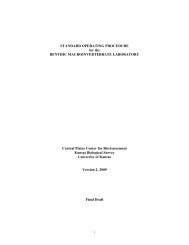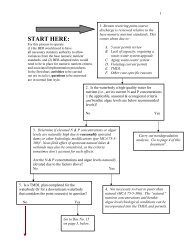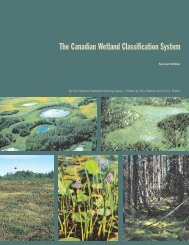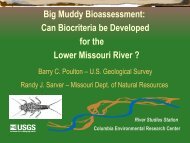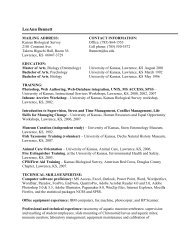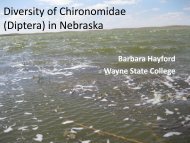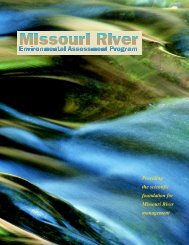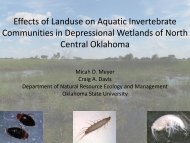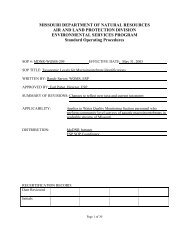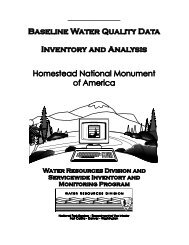Koontz, J., D.G. Huggins, C.C. Freeman, D.S. Baker - Central Plains ...
Koontz, J., D.G. Huggins, C.C. Freeman, D.S. Baker - Central Plains ...
Koontz, J., D.G. Huggins, C.C. Freeman, D.S. Baker - Central Plains ...
You also want an ePaper? Increase the reach of your titles
YUMPU automatically turns print PDFs into web optimized ePapers that Google loves.
was inevitable, but care was taken to avoid redundancies in scoring. Metrics dealing directly<br />
with the classification scheme used in this study (i.e. depth and the temporal dimension of<br />
inundation) were also left out. Finally, metrics pertaining to the water and floristic quality<br />
response variables measured in the field that deal with known ecological impacts of disturbance<br />
were limited so as not to affect adversely a comparison with data from a Floristic Quality<br />
Assessment.<br />
The resulting assessment method is advantageous in the sense that it is a subjective scoring<br />
process in which the user is evaluating human impacts without being asked to make specific<br />
judgments about the more technical aspects of wetland ecological integrity. Though the three<br />
sections in the disturbance assessment are meant to be used together to estimate an overall score<br />
for a wetland or specific area within a wetland complex. In addition attributes and scoring<br />
within each of the three sections can be examine individually to more specifically assess or<br />
describe certain wetland characteristics or trends in wetland condition.<br />
Table 1. Assessment parameters used in quantifying disturbance. Wetland attributes are scored<br />
up to 3 points each, and reference and disturbance parameters ±1 point. See Appendix D for<br />
field sheet used in scoring.<br />
Wetland Attributes<br />
Three wetland size classes (50 acres) were selected based on the<br />
range of surface areas for individual wetlands and wetland complexes in the lower Missouri<br />
River floodplain and the findings of other rapid assessment methods (e.g., the Ohio Rapid<br />
Assessment Method) gauged as appropriately “large” wetlands.<br />
Natural buffer width or buffer thickness was an important metric according to several published<br />
assessment methods. Natural buffers are thought to provide protection against local<br />
disturbances.<br />
11 of 84



